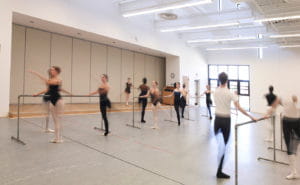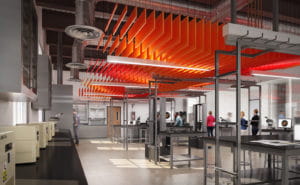University campuses are often noted for their classic architecture, with buildings that can date back 100 years or more. Yet tradition and history – while important – run a distant second when students are shopping for the best higher education fit. That’s why leaders who want to keep their programs competitive must look at more than just the excellence of their faculty. They also need to consider the broader factors that today’s students are looking for – namely flexible classrooms, comfortable living spaces, access to cutting-edge technology and plenty of open areas that make it easy to socialize in large or small groups, said FSB Senior Principal Fred Schmidt.
“For a long time, education buildings were very institutional in appearance. There was no focus on holistic designs that take into account the entire student experience,” Schmidt said. “That has changed significantly over the years, to where it’s now a combination of the programs and the physical environment. Today’s students aren’t just seeking state-of-the-art facilities for their particular field of study. They’re also looking for dormitories, cafeterias, fitness centers and other gathering spaces that offer a more fun and homelike feel.”
The impact of a building on student recruitment efforts can be particularly enhanced when an educational program requires a highly technical or otherwise specialized facility. For instance, FSB transformed a run-down traditional classroom building into a cutting-edge dance instruction facility for Oklahoma City University’s top-tier Ann Lacy School of American Dance. In 2017, the school was named the best dance program in the country by OnStage, a national media outlet that covers the performing arts. The facility designed by FSB is cited among the reasons for its success.

Over the years, FSB has designed a number of highly successful modern learning environments and other facilities for its education clients, and these have had a significant impact on student recruitment, Schmidt noted. Some examples:
The Forensic Science Institute, created for the University of Central Oklahoma’s top-tier forensics program. With its state-of-the-art technology and flexible design, the facility isn’t just used by students — forensic professionals from across the country routinely visit for continuing education training.
The Oklahoma City University School of Law is now housed in the city’s original high school building, which was constructed in 1910 and is listed on the National Register of Historic Places. FSB’s design maintained the building’s historic integrity while incorporating state-of-the-art technology, a functioning courtroom and other modern learning features. Since its completion, admissions to the prestigious program have steadily risen.
The CEAT Lab, designed for long-time client Oklahoma State University, is the newest undergraduate facility for its College of Engineering, Architecture and Technology. Competition for these students is intense, and the new lab — equipped with such unique features as drone testing capabilities — is already a major selling point for campus recruiters.

Creating a Holistic Atmosphere
Along with the educational facilities, students are increasingly choosing campus environments with café-style cafeterias, comfortable and technology-friendly dorms, fitness/wellness centers and student unions that create opportunities to interact. Over the years FSB has designed dozens of these types of facilities, most recently new dormitories and a newly renovated kitchen for Northern Oklahoma College, which are also being used for recruitment purposes.
“What it boils down to is that these physical environments play a very important role in student recruitment,” Schmidt said. “Students today want spaces that feel comfortable, no matter what they are. There has been a generational shift, with the result that the opportunities for social interaction have increased tremendously, and that needs to be reflected in everything from the classroom to the cafeteria and beyond.”
For more information about education building design as a recruitment tool, contact Laure Majors at [email protected], (405) 840-2931.